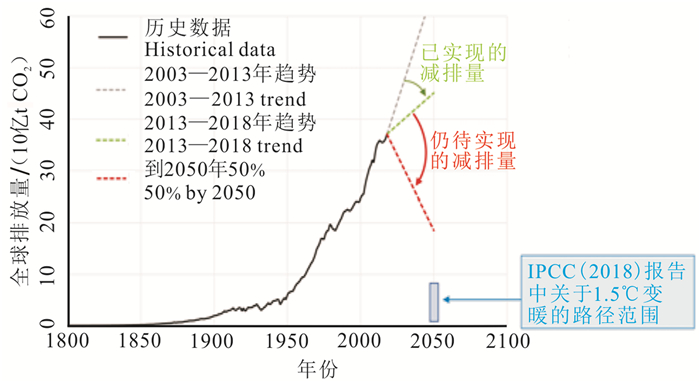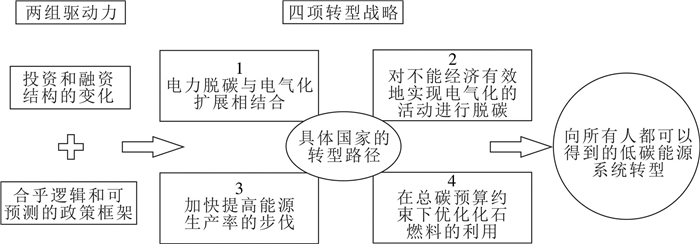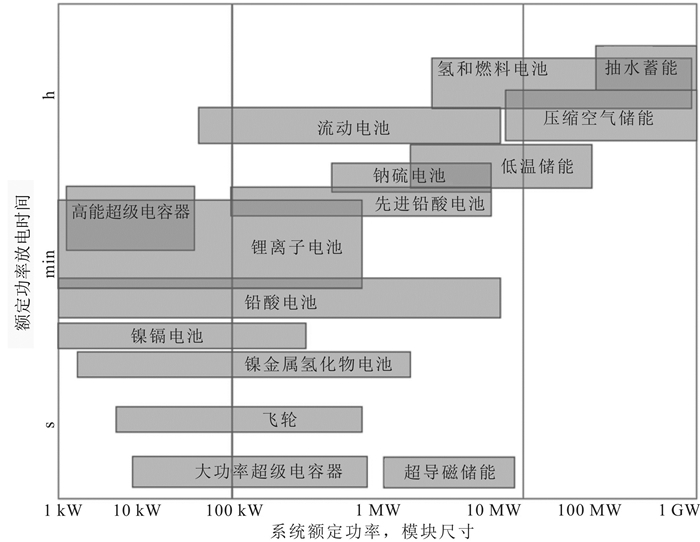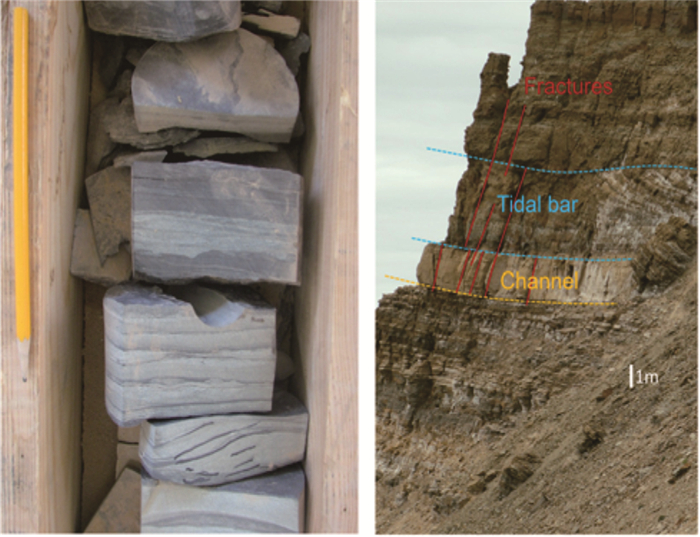-
摘要:
碳中和是当前世界关注的热点,地球科学可以在其中发挥很大的作用。在国际上,政府间气候变化专门委员会、国际能源署、能源转型委员会,以及在国家层面,政策咨询小组已就CO2减排可能的实现方式提出了一系列模型和预测情景,表明要实现碳中和,电将代替化石燃料成为全球能源的主要载体。在全球迫切需要减排的背景下,地球科学为实现《巴黎协定》气候目标提供地质解决方案至关重要,主要科学问题涉及:储热与地热;干热岩;水电储能;压缩空气储能;核能;碳捕集与储存;氢经济;能源转型需要的矿产原材料。这就需要地球科学:一是对岩石进行地球化学和地质体的岩石力学特征描述,以便在可能开展脱碳的地区储存CO2和建立绿色能源系统;二是进一步揭示电动汽车电池和风力涡轮机等所需矿产资源的起源和成因;三是从小型实验室尺度扩大到试点、工业化和商业化全尺度规模;四是要了解公众对地下脱碳技术的态度,保证项目安全性。碳中和目标为地球科学研究提供了新的机遇,未来发展需要从多方面提供支持;提高对地球科学在实现脱碳方面关键作用的认识,并发展技术,打造产业链,实现可持续发展。
Abstract:Carbon neutralization is a hot topic in the world, and geoscience can play an important role in this field. Internationally, the Intergovernmental Panel on Climate Change, the International Energy Agency, the Energy Transition Commission, and policy advisory groups at the national level have proposed a series of models and scenarios for possible ways to reduce CO2 emissions, indicating that to achieve carbon neutrality, electricity will replace fossil fuels as the main carrier of global energy. In the context of global urgent need for CO2 emission reduction, it is very important for geosciences to provide geological solutions to achieve the climate objectives of the Paris Agreement. Carbon dioxide emission reduction involves many scientific issues, including heat storage and geothermal, dry hot rock, hydropower energy storage, compressed air energy storage, nuclear energy, carbon capture and storage, hydrogen economy and mineral raw materials for energy transformation. Earth science can help reducing carbon dioxide emissions through the following ways: first, to describe the rock mechanics characteristics of geological body, so as to store CO2 and establish green energy system in the decarbonization area; secondly, to further reveal the origin and genesis of the mineral resources needed for electric vehicle batteries and wind turbines; thirdly, to expand the scale from small laboratory to pilot, industrialization and commercialization; and fourthly, to understand the public's attitude towards underground decarbonization technology to ensure the safety of the project. The goal of carbon neutralization provides new opportunities for geoscience research, and the future development needs support from various aspects. Achieving carbon neutrality requires improving awareness of the key role of geoscience in achieving decarbonization, developing technologies, building industrial chains, and achieving sustainable development.
-
1. 研究目的(Objective)
松科二井,获取了从基底—火石岭组—沙河子组—营城组—登娄库组下部连续完整的原位岩心。本文对松科二井沙河子组上部的孢粉化石进行研究,为研究白垩纪地球温室气候和环境变化,建立服务“百年大庆”目标和基础地质研究的“金柱子”提供基础资料。
2. 研究方法(Methods)
孢粉样品采自松科二井3395.46~3901.35 m,岩性为黑色、灰黑色泥岩、粉砂质泥岩,层位为沙河子组上部。孢粉分析鉴定在吉林大学古生物学与地层学研究中心完成,具体过程为:每个样品取过筛的干样50 g,进行盐酸→氢氟酸→氢氧化钾→盐酸→硝酸→氢氧化钾→盐酸等分析处理,用筛选法将样品中的孢粉化石集中在试管中,制2个固定片在生物显微镜下鉴定。
3. 研究结果(Results)
依据松科二井3395.46~3901.35 m井段的孢粉化石演化特征,划分出两个孢粉组合。
(1)Leiotriletes sp.- Cyathidites australis - Chasmatosporites sp.组合(简称LCC组合),分布在3832.94~3901.35m井段。蕨类孢子占绝对优势,裸子类花粉较低,未见被子类花粉。蕨类孢子含量最高的是Cyathidites australis,其次是Leiotriletes sp.和Cyclogranisporites sp.,有时代意义的还有Cicatricosisporites exilis、C. minutaestriatus、C. splendidus、C.australiensis、Klukisporites sp.、Maculatisporites sp.、Triporoletes singularis、Trilobosporites tribotrys、Aequitriradites sp.和Polycingulatisporites reduncus等;裸子类花粉含量最高的是Chasmatosporites sp.,其次是Psophosphaera sp.,有时代意义的类型有Parvisaccites sp.、Erlianpollis minisculus、Paleoconifersp.、Pseudowalchia sp.和Classopollis sp.等。
(2)Klukisporites triangulus- Aequitriradites sp.- Pristinuspollenites sp.组合(简称KAP组合),分布在3395.46~3613.62 m井段。裸子类花粉百分含量(53.03%~72.13%)较高,其次为蕨类孢子(27.87% ~46.97%),未见到被子类花粉。裸子类花粉中含量最高的是Alisporites parvus,其次是Piceaepollenites sp.,含量较高的类型还有Chasmatosporites sp.、Pinuspollenites divulgatus和P. sp.等,有时代意义的还有Parvisaccites otagoensis、Erlianpollis minisculus、E. mediocris、Jiaohepollis sp.和Classopollis classoides等。蕨类孢子含量最高的是Klukisporites sp.,其次是Leiotriletes sp.和Cyathidites australis,含量较高的类型还有Cyclogranisporites sp.等,有时代意义的有Cicatricosisporites exilis、C.apiteretus、C. australiensis、Klukisporites triangulus、K.variegatus、Pilosisporites scitulus、Impardecispora sp.、Levisporites wulinensis、Triporoletes singularis、Trilobosporites humilis、Aequitriradites sp.和Schizaeoisporites sp.等。
含有早白垩世特有或在早白垩世繁盛的分子:Cicatricosisporites、Klukisporites、Pilosisporites、Maculatisporites、Impardecispora、Levisporites、Triporoletes、Trilobosporites、Aequitriradites、Schizaeoisporites、Polycingulatisporites、Parvisaccites、Paleoconiferus、Erlianpollis、Foveotriletes.和Classopollis等(图 1)。
![]() 图 1 松科二井沙河子组部分孢粉化石(1-Cicatricosisporites exilis,样品号:SK2-375;2. -Cicatricosisporites minutaestriatus,标品号:SK2-385;3-Cicatricosisporites splendidus,标品号:SK2-385;4-Cicatricosisporites australiensis,样品号(sample number):SK2-375;5-Levisporites wulinensis,样品号(sample number):SK2-205;6. Aequitriradites sp.,样品号(sample number):SK2-389; 7-Trilobosporites tribotrys,样品号(sample number):SK2-389;8- Classopollis classoides,标品号:SK2-97;9-Erlianpollis minisculus,样品号(number):SK2-395; 10. Parvisaccites sp.,样品号:SK2-395;11. Pilosisporites scitulus,标品号:SK2-201;12-Triporoletes asper,标品号(specimen number):SK2-219;13. Foveotriletes subtriangulularis,样品号:SK2-219;14-Klukisporites triangulus,样品号(sample number):SK2-205;15-Impardecispora sp.,样品号:SK2-201; 16-Schizaeoisporites polaris,样品号:SK2-173;17-Polycingulatisporites reduncus,标品号:SK2-395;18-Maculatisporites sp.,样品号:SK2-391。19-Chasmatosporites sp.,样品号:SK2-389; 20-Paleoconiferae sp.,样品号(sample number):SK2-391;线段比例尺为10 μm, the scale of the line segment is 10 μm)Figure 1. Spores and pollen from the Lower Cretaceous Shahezi Formation in Well SK2
图 1 松科二井沙河子组部分孢粉化石(1-Cicatricosisporites exilis,样品号:SK2-375;2. -Cicatricosisporites minutaestriatus,标品号:SK2-385;3-Cicatricosisporites splendidus,标品号:SK2-385;4-Cicatricosisporites australiensis,样品号(sample number):SK2-375;5-Levisporites wulinensis,样品号(sample number):SK2-205;6. Aequitriradites sp.,样品号(sample number):SK2-389; 7-Trilobosporites tribotrys,样品号(sample number):SK2-389;8- Classopollis classoides,标品号:SK2-97;9-Erlianpollis minisculus,样品号(number):SK2-395; 10. Parvisaccites sp.,样品号:SK2-395;11. Pilosisporites scitulus,标品号:SK2-201;12-Triporoletes asper,标品号(specimen number):SK2-219;13. Foveotriletes subtriangulularis,样品号:SK2-219;14-Klukisporites triangulus,样品号(sample number):SK2-205;15-Impardecispora sp.,样品号:SK2-201; 16-Schizaeoisporites polaris,样品号:SK2-173;17-Polycingulatisporites reduncus,标品号:SK2-395;18-Maculatisporites sp.,样品号:SK2-391。19-Chasmatosporites sp.,样品号:SK2-389; 20-Paleoconiferae sp.,样品号(sample number):SK2-391;线段比例尺为10 μm, the scale of the line segment is 10 μm)Figure 1. Spores and pollen from the Lower Cretaceous Shahezi Formation in Well SK2上述2个孢粉组合分布在,属沙河子组上部,LCC组合蕨类孢子百分含量占绝对优势,裸子类花粉较少,从组合特点来看,可以与高瑞琪等人建立的沙河子组上部Granulatisporites-Lophotriletes-Cicatricosisporites组合大致对比,但上部的KAP组合层位显然高于高瑞琪等人建立的孢粉组合。与高瑞琪等人建立的孢粉组合相比,当前孢粉组合出现的有时代意义的孢粉类型更多且时代更新。
4. 结论(Conclusions)
两个孢粉组合海金砂科孢子繁盛,类型多样化,没有发现早期被子植物花粉;虽在蕨类孢子与裸子类花粉的百分含量及属种构成上明显不同,但出现的有时代意义的化石类型基本相同,其时代均为早白垩世早期。
5. 致谢(Acknowledgement)
本文为国家自然科学基金项目(41790451)和中国地质调查局项目(DD20190097)共同资助。孢粉化石由张淑琴研究员鉴定。
-
图 3 能源转型委员会(2017年)4个转型战略(据Lindsay Delevingne et al., 2020)
Figure 3. Four transition strategies of the Energy Transitions Commission (2017)(after Lindsay Delevingne et al., 2020)
图 5 储存场地的地质特征(据Phil Ringrose,2019)
(左图阿尔及利亚克雷奇巴石炭纪储集单元潮汐三角洲岩相典型岩心样品;右图格陵兰中侏罗纪尼尔—克林特组潮汐三角洲沉积结构的露头代表)
Figure 5. Geological characteristics of storage-site(after Phil Ringrose, 2019)
(left) example core samples from a tidal delta lithofacies from the Carboniferous storage unit at Krechba, Algeria; and (right) outcrop analogue of tidal deltaic sedimentary architecture from the Middle Jurassic Neill Klinter Formation, Greenland. (Photographs courtesy of Phil Ringrose)
表 1 联合国可持续发展目标到2030年的目标和指标
Table 1 The 2030 goals and targets of the United Nations Sustainable Development Goals (SDGs)

-
Benjamin K, Sovacool, Saleem H, Ali Morgan Bazilian, Ben Radley, Benoit Nemery, Julia Okatz, Dustin Mulvaney. 2020. Sustainable minerals and metals for a low-carbon future[J]. Science, 367(6473): 30-33. doi: 10.1126/science.aaz6003
Brad Page, Guloren Turan, Alex Zapantis. 2019. Global Status of CCS 2019[R]. Melbourne: Global Carbon Capture and Storage Institute Ltd.
Carbon Brief. 2015. Nuclear power additions 'need to quadruple' to hit climate goals, IEA says[EB/OL]. [2015-01-31]. https://www.carbonbrief.org/nuclear-power-additions-need-to-quadruple-to-hit-climate-goals-iea-says.
China Petrochemical News. 2019. Definition and resources of dry hot rock[EB/OL]. [2019-12-23]. http://202.149.227.159/zgshb/html/2019-12/23/content_841175.htm?div=-1.
CHUNENG. BJX. COM. CN. 2016. How many of the world's top ten pumped storage power stations do you know?[EB/OL]. [2016-01-22]. http://chuneng.bjx.com.cn/news/20160122/703734.shtml.
Committee on Climate Change. 2019. Net Zero: The UK's Contribution to Stopping Global Warming[R]. London: Committee on Climate Change.
Energy Transitions Commission. 2017. Better Energy, Greater Prosperity Achievable Pathways to Low-carbon Energy Systems[R]. Energy Transitions Commission.
ESA. 2021 Variable Speed Pumped Hydroelectric Storage[EB/OL]. [2021-02-01]. http://energystorage.org/why-energy-storage/technologies/variable-speed-pumped-hydroelectric-storage/.
Gibbins J, Chalmers H. 2008. Carbon capture and storage[J]. Energy Policy, 36: 4317-4322. doi: 10.1016/j.enpol.2008.09.058
Goldthau A, Westphal K, Bazilian M, Bradshaw M. 2019. Model and manage the changing geopolitics of energy[J]. Nature, 569: 29-31. doi: 10.1038/d41586-019-01312-5
Helen Mountford. 2020. Responding to Coronavirus: Low-carbon Investments Can Help Economies Recover. [EB/OL]. [2020-03-12]. https://www.wri.org/blog/2020/03/coronavirus-economy-low-carbon-investments.
He Wei, Dooner Mark, King Marcus, Li Dacheng, Guo Songshan, Wang Jihong. 2021. Techno-economic analysis of bulk-scale compressed air energy storage in power system decarbonisation[J]. Applied Energy, 282(PA): 1-15. http://www.sciencedirect.com/science/article/pii/S0306261920315208
IEA. 2020. CCUS in Clean Energy Transitions[EB/OL]. [2020-09-01]. https://www.iea.org/reports/ccus-in-clean-energy-transitions/a-new-era-for-ccus#abstract.
IEA. 2018. World Energy Outlook 2018[R]. Paris: International Energy Agency.
IPCC. 2018. Summary for policymakers//Masson-Delmotte V, Zhai P. (eds.). Global Warming of 1.5℃. An IPCC Special Report on the Impacts of Global Warming of 1.5℃ Above Pre-industrial Levels and Related Global Greenhouse Gas Emission Pathways, in the Context of Strengthening the Global Response to the Threat of Climate Change, Sustainable Development, and Efforts to Eradicate Poverty[R]. Geneva: World Meteorological Organization.
IRENA. 2019. Global Energy Transformation: A Roadmap to 2050[R]. Abu Dhabi: International Renewable Energy Agency.
Johannes Friedrich, Thomas Damassa, Mengpin Ge. 2015. What Will Future Emissions Look Like?[EB/OL]. [2015-03-09]. https://www.wri.org/blog/2015/03/what-will-future-emissions-look.
Jose M Bermudez, Taku Hasegawa. 2020. Hydrogen: More efforts needed[EB/OL]. [2020-06]. https://www.iea.org/reports/hydrogen.
Kirsten Hund, Daniele La Porta, Thao P. Fabregas. 2020. Minerals for Climate Action: The Mineral Intensity of the Clean Energy Transition[R]. Washington, DC: The World Bank.
Lindsay Delevingne, Will Glazener, Liesbet Grégoir. 2020. Climate risk and decarbonization: What every mining CEO needs to know[R]. New York City: Mckinsey&Company.
Mao Xiang, Guo Dianbin, Luo Lu, Wang Tinghao. 2019. The global development process of hot dry rock (enhanced geothermal system) and its geological background[J]. Geological Review, 65(6): 1462-1472(in Chinese with English abstract). http://en.cnki.com.cn/Article_en/CJFDTotal-DZLP201906018.htm
Mark P Mills. 2020. Mines, Minerals, And "Green" Energy: A Reality Check[R]. New York: Manhattan Institute.
Michael H. Stephenson, Philip Ringrose, Sebastian Geiger, Michael Bridden, David Schofield. 2019. Geoscience and decarbonization: current status and future directions[J]. Petroleum Geoscience, 25: 501-508. doi: 10.1144/petgeo2019-084
Michel Berthélemy, Sama Bilbao Y Leon. 2020. Nuclear Power[EB/OL]. [2020-06]. https://www.iea.org/reports/nuclear-power.
Mike Stephenson, Florence Bullough. 2020. Geological skills and knowledge crucial in delivering net-zero[J]. Science in Parliament, 75(4): 11-13. http://www.researchgate.net/publication/343683028_Negotiation_Skills_Crucial_in_Resolving_Differences_and_Disagreement_between_Individuals
Mining Online. 2017. Major breakthrough in emerging clean energy exploration may rewrite the traditional energy map[EB/OL]. [2017-09-07]. https://www.sohu.com/a/190453433_740265.
Northern Gas Networks. 2018. H21 North of England-national launch[EB/OL]. [2018-11-26]. https://www.northerngasnetworks.co.uk/event/h21-launches-national/.
Pacala S, Socolow R. 2004. Stabilization wedges: Solving the climate problem for the next 50 years with current technologies[J]. Science, 305: 968-972. doi: 10.1126/science.1100103
Ringrose P S. 2017. Principles of sustainability and physics as a basis for the low-carbon energy transition[J]. Petroleum Geoscience, 23: 287-297. doi: 10.1144/petgeo2016-060
Ryan Morrison. 2021. The earth will reach a critical point in 30 years[N]. Reference News, 1.27(9).
S Julio Friedmann, Alex Zapantis, Brad Pag. 2020. Net-Zero And Geospheric Return: Actions Today For 2030 And Beyond[R]. Amsterdam: Columbia University CGEP.
Stephenson M. 2018. Energy and climate change: Geological controls, interventions, and mitigations[J]. Energy & Climate Change, 2018: 175-178. http://www.sciencedirect.com/science/article/pii/B9780128120217000099
Wang Guiling. 2020. Develop new geothermal energy and build a clean, low-carbon, safe and efficient energy system[J]. Acta Geologica Sinica, 94(7): 1921-1922(in Chinese with English abstract).
www. tanjiaoyi. com. 2020. Which countries and regions in the world have set the goal of carbon neutrality (net zero emission)?[EB/OL]. [2020-09-01]. http://www.tanjiaoyi.com/article-32125-1.html.
Yang Jianfeng, Wang Yao, Ma Teng, Zhang Cuiguang. 2019. Current status and strategies of exploration and development of Hot Dry Rock geothermal energy in the United States and implications for China[J]. Land and Resources Information, (6): 8-14, 56(in Chinese with English abstract). http://en.cnki.com.cn/Article_en/CJFDTotal-GTZQ201906002.htm
北极星储能网. 2016. 世界十大抽水蓄能电站你知道几个?[EB/OL]. [2016-01-22]. http://chuneng.bjx.com.cn/news/20160122/703734.shtml. 瑞安·莫里森. 2021. 地球三十年内将达致命临界点[N]. 参考消息, 1.27(9). 矿业在线. 2017. 新兴清洁能源勘查获重大突破, 或将改写传统能源版图[EB/OL]. [2017-09-07]. https://www.sohu.com/a/190453433_740265. 毛翔, 国殿斌, 罗璐, 王婷灏. 2019. 世界干热岩地热资源开发进展与地质背景分析[J]. 地质论评, 65(6): 1462-1472. https://www.cnki.com.cn/Article/CJFDTOTAL-DZLP201906018.htm 王贵玲. 2020. 开发地热新能源, 构建清洁低碳、安全高效的能源体系[J]. 地质学报, 94(7): 1921-1922. https://www.cnki.com.cn/Article/CJFDTOTAL-DZXE202007001.htm 杨建锋, 王尧, 马腾, 张翠光. 2019. 美国干热岩地热资源勘查开发现状、战略与启示[J]. 国土资源情报, (6): 8-14, 56. https://www.cnki.com.cn/Article/CJFDTOTAL-GTZQ201906002.htm 中国碳交易网. 2020. 全球哪些国家和地区设立了碳中和(净零排放)目标?[EB/OL]. [2020-09-01]. http://www.tanjiaoyi.com/article-32125-1.html. 中国石化报. 2019. 干热岩定义与资源量[EB/OL]. [2019-12-23]. http://202.149.227.159/zgshb/html/2019-12/23/content_841175.htm?div=-1. -
期刊类型引用(2)
1. 吴怀春,李山,王成善,褚润健,王璞珺,高远,万晓樵,贺怀宇,邓成龙,杨光,黄永建,高有峰,席党鹏,王天天,房强,杨天水,张世红. 松辽盆地白垩纪综合年代地层格架. 地学前缘. 2024(01): 431-445 .  百度学术
百度学术
2. 张德军,郑月娟,张淑芹,张健,黄欣,陈树旺,孙雷. 松科2井早白垩世沙河子组孢粉组合及其古气候意义. 地质通报. 2024(Z1): 429-442 .  百度学术
百度学术
其他类型引用(2)




 下载:
下载:





